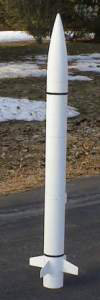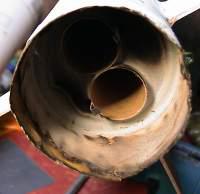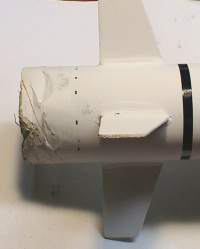| Construction Rating: | starstarstarstar_borderstar_border |
| Flight Rating: | starstarstarstar_borderstar_border |
| Overall Rating: | starstarstarstar_borderstar_border |
| Published: | 2011-06-01 |
| Diameter: | 2.60 inches |
| Manufacturer: | The Launch Pad  |
| Skill Level: | 3 |
| Style: | Scale |
 Brief:
Brief:
Dual "D" engine scale model of the UK/Germany Advanced Short Range Air to Air Missile (ASRAAM).
Construction:
This Launch Pad rocket is exactly like all the other TLP kits.
The Kit contains:
- Plastic nose cone
- Cardboard body tubes (2)
- Balsa fins
- Shock cord attachment & engine mounting the same as the older Estes rockets.
- Parachute is purple mylar.
The quality of the parts is OK with the nosecone of better quality than I have seen in other kits.
Instructions are illustrated and are pretty basic and simple to follow. Assembly starts with the dual engine mount and then the body tube. This rocket has clean lines and is a very basic 4 finned and a nose cone rocket.
Templates are supplied for the fins and shock cord anchor. For some reason the TLP never includes any information on launch lugs so one has to figure out where to put them. I put mine between the fins and half way up the body.
Finishing:
Although no decals are included, there is alot of information on marking and painting the rocket.
Construction Rating: 3 out of 5
Flight:
I have flown mine 2 times. Once with D12-3 and once with D12-5. Both seem to work fine. Of course you have to use enough wadding to protect the chute. Looking at the rocket you may be concerned with how well it would fly with the small fins it has and it being a dual engine rocket with a lot of weight at the rear. But surprisingly it flew great both times. Nice, straight and ejection at the proper time.
 Recovery:
Recovery:
Unfortuanately mine suffers from 2 problems. First, because the engines are recessed a bit, the inside of the body tube gets a little burnt! See picture. Secondly, with dual engines it is aft heavy when coming down. That compounded with a chute not fully open caused some minor damage to the bottom of the rocket. See picture.
If I were to build again, I would put a reinforcement ring inside the bottom of the rocket to strengthen and help protect it from the flames.
 Flight Rating: 3 out of 5
Flight Rating: 3 out of 5
Summary:
Pros:
- Nice, clean lines
- High quality nosecone
- Easy to assemble
- Dual engines
- Stable flyer, more stable than my other TLP kits with larger fins, weighs only 6 ozs so you can get some good height on dual engines, you could probably also fly it on dual C11-3s.
Overall Rating: 3 out of 5
Other Reviews
- The Launch Pad ASRAAM By Larry Brand
ASRAAM is a scale kit by The Launch Pad that models a prototype of a thrust-vectored air-to-air missile. As such, it sports a set of dinky fins that suggest not too much of a stability margin. In fact, ASRAAM is not only exceptionally stable in flight, but is an excellent, easy-building sport flyer, and a good choice for a first cluster model (it uses a pair of 24mm motors). Surprisingly, flight ...
 |
 |
Flights
 |
 |
C.J.B. (July 2, 2005)
Sponsored Ads
 |
 |












L.B. (May 5, 2003)